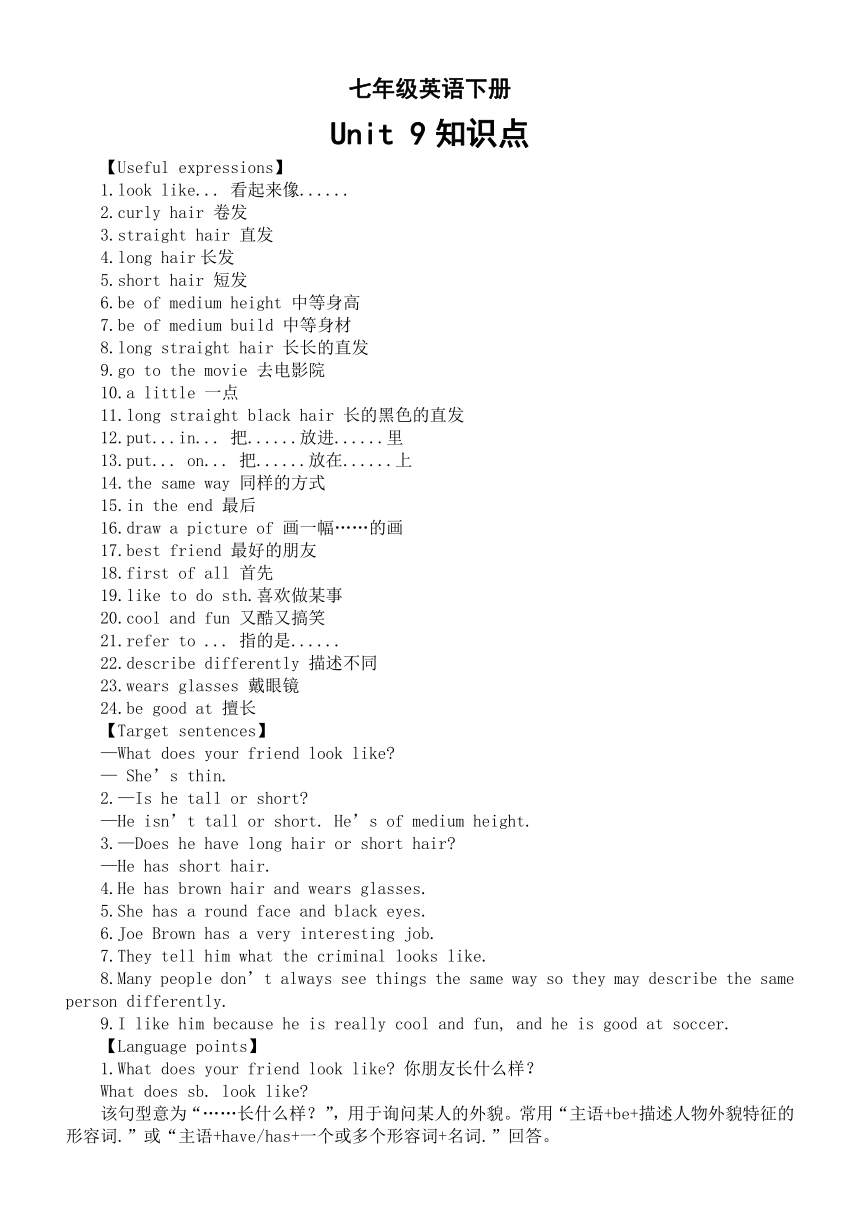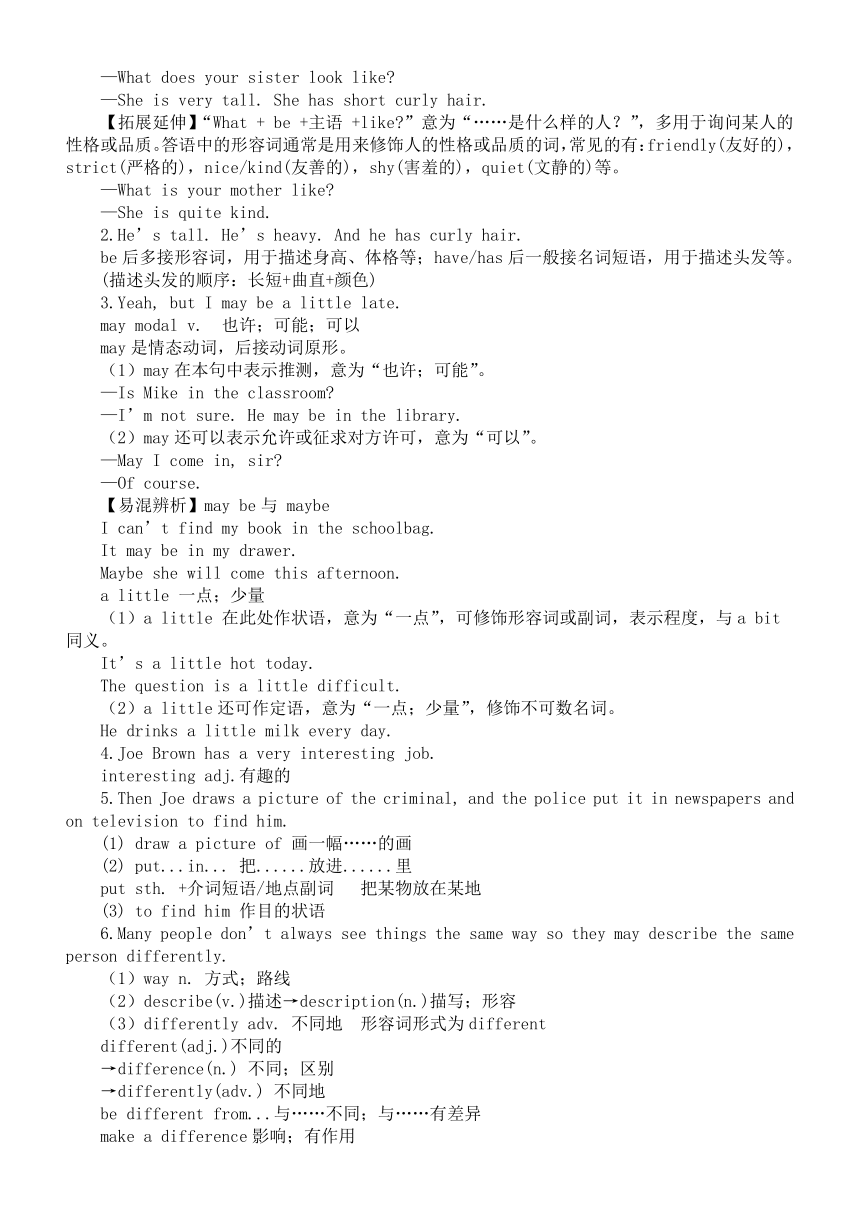Unit 9 What does he look like?知识整理-2023-2024学年人教版英语七年级下册
文档属性
| 名称 | Unit 9 What does he look like?知识整理-2023-2024学年人教版英语七年级下册 |

|
|
| 格式 | docx | ||
| 文件大小 | 43.2KB | ||
| 资源类型 | 教案 | ||
| 版本资源 | 人教新目标(Go for it)版 | ||
| 科目 | 英语 | ||
| 更新时间 | 2024-05-17 14:30:21 | ||
图片预览


文档简介
七年级英语下册
Unit 9知识点
【Useful expressions】
1.look like... 看起来像......
2.curly hair 卷发
3.straight hair 直发
4.long hair长发
5.short hair 短发
6.be of medium height 中等身高
7.be of medium build 中等身材
8.long straight hair 长长的直发
9.go to the movie 去电影院
10.a little 一点
11.long straight black hair 长的黑色的直发
12.put...in... 把......放进......里
13.put... on... 把......放在......上
14.the same way 同样的方式
15.in the end 最后
16.draw a picture of 画一幅……的画
17.best friend 最好的朋友
18.first of all 首先
19.like to do sth.喜欢做某事
20.cool and fun 又酷又搞笑
21.refer to ... 指的是......
22.describe differently 描述不同
23.wears glasses 戴眼镜
24.be good at 擅长
【Target sentences】
—What does your friend look like
— She’s thin.
2.—Is he tall or short
—He isn’t tall or short. He’s of medium height.
3.—Does he have long hair or short hair
—He has short hair.
4.He has brown hair and wears glasses.
5.She has a round face and black eyes.
6.Joe Brown has a very interesting job.
7.They tell him what the criminal looks like.
8.Many people don’t always see things the same way so they may describe the same person differently.
9.I like him because he is really cool and fun, and he is good at soccer.
【Language points】
1.What does your friend look like 你朋友长什么样?
What does sb. look like
该句型意为“……长什么样?”,用于询问某人的外貌。常用“主语+be+描述人物外貌特征的形容词.”或“主语+have/has+一个或多个形容词+名词.”回答。
—What does your sister look like
—She is very tall. She has short curly hair.
【拓展延伸】“What + be +主语 +like ”意为“……是什么样的人?”,多用于询问某人的性格或品质。答语中的形容词通常是用来修饰人的性格或品质的词,常见的有:friendly(友好的),strict(严格的),nice/kind(友善的),shy(害羞的),quiet(文静的)等。
—What is your mother like
—She is quite kind.
2.He’s tall. He’s heavy. And he has curly hair.
be后多接形容词,用于描述身高、体格等;have/has后一般接名词短语,用于描述头发等。
(描述头发的顺序:长短+曲直+颜色)
3.Yeah, but I may be a little late.
may modal v. 也许;可能;可以
may是情态动词,后接动词原形。
(1)may在本句中表示推测,意为“也许;可能”。
—Is Mike in the classroom
—I’m not sure. He may be in the library.
(2)may还可以表示允许或征求对方许可,意为“可以”。
—May I come in, sir
—Of course.
【易混辨析】may be与 maybe
I can’t find my book in the schoolbag.
It may be in my drawer.
Maybe she will come this afternoon.
a little 一点;少量
(1)a little 在此处作状语,意为“一点”,可修饰形容词或副词,表示程度,与a bit同义。
It’s a little hot today.
The question is a little difficult.
(2)a little还可作定语,意为“一点;少量”,修饰不可数名词。
He drinks a little milk every day.
4.Joe Brown has a very interesting job.
interesting adj.有趣的
5.Then Joe draws a picture of the criminal, and the police put it in newspapers and on television to find him.
(1) draw a picture of 画一幅……的画
(2) put...in... 把......放进......里
put sth. +介词短语/地点副词 把某物放在某地
(3) to find him 作目的状语
6.Many people don’t always see things the same way so they may describe the same person differently.
(1)way n. 方式;路线
(2)describe(v.)描述→description(n.)描写;形容
(3)differently adv. 不同地 形容词形式为different
different(adj.)不同的
→difference(n.) 不同;区别
→differently(adv.) 不同地
be different from...与……不同;与……有差异
make a difference影响;有作用
7.He wants to draw a good picture of each criminal.
each adj. & pron. 每个;各自
(1) each作形容词,用于名词前作定语,修饰可数名词单数。
Each school has its own library.
(2) each还可作代词:
①可单独作主语,也可接介词of,“each of +复数名词/代词”作主语时, 谓语动词通常用单数形式。
There are five boys in this group and each has his own answer.
Each of us likes English.
②可用作复数名词或代词的同位语。
注意:each作主语(复数)的同位语时,谓语动词应为复数。
You have to visit them each (=each of them).
We each (=Each of us) have different problems.
8.Another woman says, “He is tall and thin…”
another adj. & pron. 另一;又一
(1)another在句中作形容词,指三者或三者以上中的“另一个”,修饰可数名词单数。
We need another computer.
(2)another还可作代词,泛指同类事物中三者或三者以上中的“另一个;有一个”,代替可数名词单数。
I don’t like this sweater. Please show me another.
【拓展延伸】
another常用于“another+基数词(大于1)+可数名词复数”结构,相当于“基数词(大于1)+more+可数名词复数”。
We’ll have to wait another two months for the result.
= We’ll have to wait two more months for the result.
我们还得再等两个月才能知道结果。
9. In the end, the real criminal is a short and heavy old man, and he has short black hair!
in the end 最后
in the end 是固定短语,相当于at last或finally ,常放在句首或句尾作状语。其中end是名词,意为“结尾;尽头”。
In the end, we got to the top of the mountain.
【拓展延伸】end构成的常见短语:
(1)at the end of 在……的尽头/末尾,后既可跟表示时间的名词,也可跟表示地点的名词。
You can see the post office at the end of the street.
The film will be on at the end of March.
(2)by the end of 到……末为止
What will the world be like by the end of the 21st century
real adj. 真正的;真实的
副词形式为really(真正地)
10.He usually wears jeans, a T-shirt and sports shoes.
jean n. 牛仔裤
jeans是复数名词,表示“一条牛仔裤”时,常用a pair of jeans。
【拓展延伸】某些名词表示由对称的两部分构成的物体,它们常以复数形式存在。
11.She has a round face and black eyes.
face n.脸 v.面对
we have to face the problem bravely.
The girl behind Mary had a black-and-blue face .
【Grammar Focus】
询问外貌的常用表达
What does sb. look like?常用于询问某人的身材或长相,意为“某人长什么样?”。
What does your brother look like
Is your brother tall or short
Does your English teacher have straight hair or curly hair
常用答语:
1.描述某人的身高:主语+be of+形容词+height.
Our math teacher is of medium height.
2.描述某人的体型:主语+be+形容词.
Lily is very short and thin.
3.描述某人某一身体部位的特征:
主语+have/has+形容词+表示身体部位的名词.
My mother has curly hair.
4.描述某人的穿着打扮:
主语+wear(s)+glasses/表示衣着的名词.
My sister wears glasses.
限定词包括冠词(a, an, the)、物主代词、指示代词(this, that, these, those)和数词等,评述性形容词有cold, beautiful, great等。
two beautiful new green silk evening dresses 两件又新又漂亮的绿色丝绸晚礼服
一般疑问句和选择疑问句
一般疑问句用yes或no来回答;选择疑问句的两个选择项则用or连接,回答时不能用yes或no回答,而是根据实际情况选择符合事实的陈述句.
My best friend is Xu Wei. She is of medium height and she is thin. She has long straight hair. She wears glasses, but not all the time. She only wears them to read. She likes to wear skirts and dresses to school, but she usually wears T-shirt and shorts on weekend. We like the same music and movies. I like her because she always listens to me carefully and we have fun talking together.
Unit 9知识点
【Useful expressions】
1.look like... 看起来像......
2.curly hair 卷发
3.straight hair 直发
4.long hair长发
5.short hair 短发
6.be of medium height 中等身高
7.be of medium build 中等身材
8.long straight hair 长长的直发
9.go to the movie 去电影院
10.a little 一点
11.long straight black hair 长的黑色的直发
12.put...in... 把......放进......里
13.put... on... 把......放在......上
14.the same way 同样的方式
15.in the end 最后
16.draw a picture of 画一幅……的画
17.best friend 最好的朋友
18.first of all 首先
19.like to do sth.喜欢做某事
20.cool and fun 又酷又搞笑
21.refer to ... 指的是......
22.describe differently 描述不同
23.wears glasses 戴眼镜
24.be good at 擅长
【Target sentences】
—What does your friend look like
— She’s thin.
2.—Is he tall or short
—He isn’t tall or short. He’s of medium height.
3.—Does he have long hair or short hair
—He has short hair.
4.He has brown hair and wears glasses.
5.She has a round face and black eyes.
6.Joe Brown has a very interesting job.
7.They tell him what the criminal looks like.
8.Many people don’t always see things the same way so they may describe the same person differently.
9.I like him because he is really cool and fun, and he is good at soccer.
【Language points】
1.What does your friend look like 你朋友长什么样?
What does sb. look like
该句型意为“……长什么样?”,用于询问某人的外貌。常用“主语+be+描述人物外貌特征的形容词.”或“主语+have/has+一个或多个形容词+名词.”回答。
—What does your sister look like
—She is very tall. She has short curly hair.
【拓展延伸】“What + be +主语 +like ”意为“……是什么样的人?”,多用于询问某人的性格或品质。答语中的形容词通常是用来修饰人的性格或品质的词,常见的有:friendly(友好的),strict(严格的),nice/kind(友善的),shy(害羞的),quiet(文静的)等。
—What is your mother like
—She is quite kind.
2.He’s tall. He’s heavy. And he has curly hair.
be后多接形容词,用于描述身高、体格等;have/has后一般接名词短语,用于描述头发等。
(描述头发的顺序:长短+曲直+颜色)
3.Yeah, but I may be a little late.
may modal v. 也许;可能;可以
may是情态动词,后接动词原形。
(1)may在本句中表示推测,意为“也许;可能”。
—Is Mike in the classroom
—I’m not sure. He may be in the library.
(2)may还可以表示允许或征求对方许可,意为“可以”。
—May I come in, sir
—Of course.
【易混辨析】may be与 maybe
I can’t find my book in the schoolbag.
It may be in my drawer.
Maybe she will come this afternoon.
a little 一点;少量
(1)a little 在此处作状语,意为“一点”,可修饰形容词或副词,表示程度,与a bit同义。
It’s a little hot today.
The question is a little difficult.
(2)a little还可作定语,意为“一点;少量”,修饰不可数名词。
He drinks a little milk every day.
4.Joe Brown has a very interesting job.
interesting adj.有趣的
5.Then Joe draws a picture of the criminal, and the police put it in newspapers and on television to find him.
(1) draw a picture of 画一幅……的画
(2) put...in... 把......放进......里
put sth. +介词短语/地点副词 把某物放在某地
(3) to find him 作目的状语
6.Many people don’t always see things the same way so they may describe the same person differently.
(1)way n. 方式;路线
(2)describe(v.)描述→description(n.)描写;形容
(3)differently adv. 不同地 形容词形式为different
different(adj.)不同的
→difference(n.) 不同;区别
→differently(adv.) 不同地
be different from...与……不同;与……有差异
make a difference影响;有作用
7.He wants to draw a good picture of each criminal.
each adj. & pron. 每个;各自
(1) each作形容词,用于名词前作定语,修饰可数名词单数。
Each school has its own library.
(2) each还可作代词:
①可单独作主语,也可接介词of,“each of +复数名词/代词”作主语时, 谓语动词通常用单数形式。
There are five boys in this group and each has his own answer.
Each of us likes English.
②可用作复数名词或代词的同位语。
注意:each作主语(复数)的同位语时,谓语动词应为复数。
You have to visit them each (=each of them).
We each (=Each of us) have different problems.
8.Another woman says, “He is tall and thin…”
another adj. & pron. 另一;又一
(1)another在句中作形容词,指三者或三者以上中的“另一个”,修饰可数名词单数。
We need another computer.
(2)another还可作代词,泛指同类事物中三者或三者以上中的“另一个;有一个”,代替可数名词单数。
I don’t like this sweater. Please show me another.
【拓展延伸】
another常用于“another+基数词(大于1)+可数名词复数”结构,相当于“基数词(大于1)+more+可数名词复数”。
We’ll have to wait another two months for the result.
= We’ll have to wait two more months for the result.
我们还得再等两个月才能知道结果。
9. In the end, the real criminal is a short and heavy old man, and he has short black hair!
in the end 最后
in the end 是固定短语,相当于at last或finally ,常放在句首或句尾作状语。其中end是名词,意为“结尾;尽头”。
In the end, we got to the top of the mountain.
【拓展延伸】end构成的常见短语:
(1)at the end of 在……的尽头/末尾,后既可跟表示时间的名词,也可跟表示地点的名词。
You can see the post office at the end of the street.
The film will be on at the end of March.
(2)by the end of 到……末为止
What will the world be like by the end of the 21st century
real adj. 真正的;真实的
副词形式为really(真正地)
10.He usually wears jeans, a T-shirt and sports shoes.
jean n. 牛仔裤
jeans是复数名词,表示“一条牛仔裤”时,常用a pair of jeans。
【拓展延伸】某些名词表示由对称的两部分构成的物体,它们常以复数形式存在。
11.She has a round face and black eyes.
face n.脸 v.面对
we have to face the problem bravely.
The girl behind Mary had a black-and-blue face .
【Grammar Focus】
询问外貌的常用表达
What does sb. look like?常用于询问某人的身材或长相,意为“某人长什么样?”。
What does your brother look like
Is your brother tall or short
Does your English teacher have straight hair or curly hair
常用答语:
1.描述某人的身高:主语+be of+形容词+height.
Our math teacher is of medium height.
2.描述某人的体型:主语+be+形容词.
Lily is very short and thin.
3.描述某人某一身体部位的特征:
主语+have/has+形容词+表示身体部位的名词.
My mother has curly hair.
4.描述某人的穿着打扮:
主语+wear(s)+glasses/表示衣着的名词.
My sister wears glasses.
限定词包括冠词(a, an, the)、物主代词、指示代词(this, that, these, those)和数词等,评述性形容词有cold, beautiful, great等。
two beautiful new green silk evening dresses 两件又新又漂亮的绿色丝绸晚礼服
一般疑问句和选择疑问句
一般疑问句用yes或no来回答;选择疑问句的两个选择项则用or连接,回答时不能用yes或no回答,而是根据实际情况选择符合事实的陈述句.
My best friend is Xu Wei. She is of medium height and she is thin. She has long straight hair. She wears glasses, but not all the time. She only wears them to read. She likes to wear skirts and dresses to school, but she usually wears T-shirt and shorts on weekend. We like the same music and movies. I like her because she always listens to me carefully and we have fun talking together.
同课章节目录
- Unit 1 Can you play the guitar?
- Section A
- Section B
- Unit 2 What time do you go to school?
- Section A
- Section B
- Unit 3 How do you get to school?
- Section A
- Section B
- Unit 4 Don't eat in class.
- Section A
- Section B
- Unit 5 Why do you like pandas?
- Section A
- Section B
- Unit 6 I'm watching TV.
- Section A
- Section B
- Review of Units 1-6
- Unit 7 It's raining!
- Section A
- Section B
- Unit 8 Is there a post office near here?
- Section A
- Section B
- Unit 9 What does he look like?
- Section A
- Section B
- Unit 10 I'd like some noodles.
- Section A
- Section B
- Unit 11 How was your school trip?
- Section A
- Section B
- Unit 12 What did you do last weekend?
- Section A
- Section B
